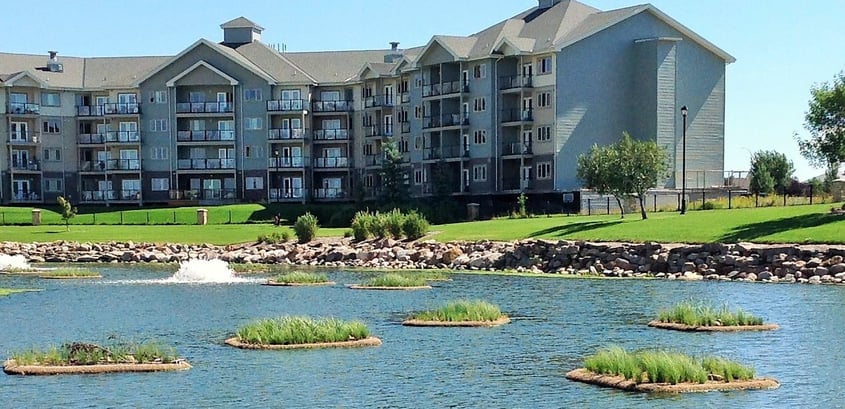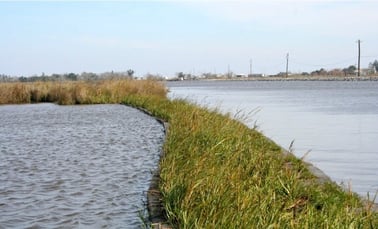
There are probably as many reasons to add a Floating Wetland to your property as there are benefits for doing so.
But we’re guessing one reason that doesn’t make the list is that you want to spend a bunch of money.
We get it. Everyone wants their landscape to be both beautiful and functional, without breaking the bank. Floating Wetlands – ticking both the beautiful and functional boxes – are no different.
If you’re thinking of installing a Floating Wetland, probably one of two things have caught your attention. One, you are having water quality issues and heard about their incredible value. Or two, you’re looking to add an eye-catching feature to a water body.
In deciding if installing a Floating Wetland is the right water quality solution for you, you really need to take a look at your other alternatives. We call this the Dark Side.
The Dark Side of Chemical Treatments
Obviously, first up on the list of the Dark Side is that you will be applying man-made chemicals straight onto a natural, living environment, where children, pets, plants and wildlife have access to. And you’ll be applying it every single year.
This isn’t the time to go over the volumes of negatives these kinds of chemicals can have on your landscape. (Although we have taken a dip into that chemically enhanced pond before.) In your spare time, google chemical treatments and “side effects.” Seriously, the shock of what you find will outweigh any shock that might come with the upfront cost of a Floating Wetland.
But honestly, when you add up the comparisons, we don’t think you’ll have sticker shock.
It’s tricky to give you a hard number. But, using a handful of examples, and taking into account that every quote, size and project is quite different, the cost of a Floating Wetland will pull even with the cost of yearly chemical treatments somewhere between 4 and 13 years.
That might sound like a long time, until you remember that after that time, you’ll still be spending that money every year in chemical treatments, while the Floating Wetland could have been making you money in year one. (More about that little gold nugget in a minute.)
The ROI for Floating Wetlands is Nearly Immediate
 If you’re a municipality, community, agency or planning board looking to install a Floating Wetland for long-term water quality, erosion control, wildlife habitat or pollution mitigation, we think the payback is actually pretty quick.
If you’re a municipality, community, agency or planning board looking to install a Floating Wetland for long-term water quality, erosion control, wildlife habitat or pollution mitigation, we think the payback is actually pretty quick.
The flip side of chemical treatments is the one-time-only design and installation costs of a Floating Wetland plus yearly stewardship visits (check out our take on stewardship vs. maintenance here). Think of it like a check-up.
So, when it comes down to weighing your options, you have to look at the whole package. The cost (environmental, social and financial) of yearly chemical treatments along with the cost of installing a Floating Wetland. And be sure to take into account the harder-to-track benefits, such as aesthetics, improved coverage of native plants, community enjoyment, increased native wildlife and maybe, if you are a big thinker, one more surprise financial benefit…
The not-so-secret solution if you’re worried about cost
Recently, we had the joy of sitting down with Bruce Kania, the founder of Floating Island International (the intellectual property behind your soon-to-be-installed Floating Wetland).
When we asked Bruce about cost concerns clients might have with Floating Wetlands, he had an easy answer.
Scale and design the project so that it pays its own way.
 Wait. What!? Floating Wetlands can actually generate revenue?
Wait. What!? Floating Wetlands can actually generate revenue?
It’s an intriguing idea, and one that can easily be achieved in a couple of different ways.
The first is to stock your pond with commercial fish. Not only will adding fish to the water increase the efficacy of the Floating Wetland design to its full potential… you can also harvest the fish!
This type of addition to your wetland is only limited by the size of your imagination. (Well, maybe a little bit by the size of your water body too.) Some documented examples are people harvesting and selling the fish as bait, or letting fishermen hop in a boat and recreate, catching healthy, happy fish.
The second idea is great for large-scale projects as it has a little more up-front capital. But it also has a potentially bigger payoff. Bruce and his team at Floating Islands International have been experimenting with, and proving, that installing solar panels on the islands can pay off the cost of the wetlands and generate a monthly income.
Ready to install your first Floating Wetland? We’re ready to help.
Don’t wait! Floating Wetlands are a proven, long-term solution and prevention to many water quality issues. Plus, the quicker we get started the quicker you can get a great ROI off your Floating Wetland. Oh yeah, and your pond or lake will also get the natural, sustainable, year-round care you can enjoy for many years to come.
Schedule a free 30-minute consultation with our team (over a Zoom!) and we'll discuss your unique property, your options, specific do's and don'ts for incorporating a Floating Wetland into your environment, and more.
Together, let’s build an island.

